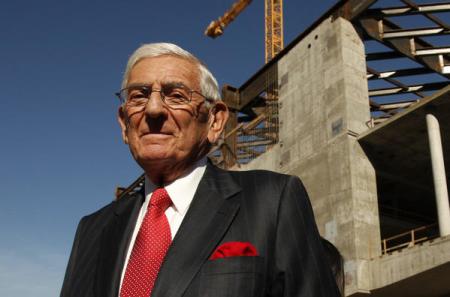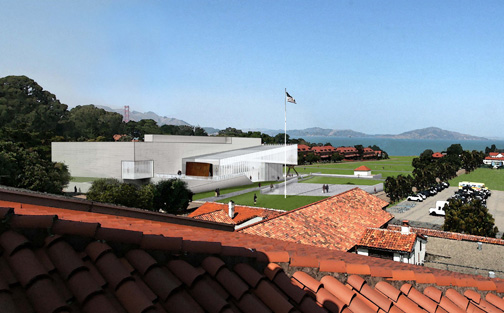Posts Tagged ‘Embarcadero’
Chapter 3 (Part 6): Private Collector Museum Conclusions
“If you look at history, too many great collections ended up in storage and not being shown.”[i] – Eli Broad
Eli Broad, like Alice Walton, the Fishers and George Lucas, has a long history with the city in which he practices his “venture philanthropy.” Broad was not born in Los Angeles, but like the Fishers in San Francisco, he has a long involved history with existing arts and cultural institutions. He has sat and currently sits on the boards of many art museums. Like the Fishers, Lucas and Walton, his decision to build a museum to house his art collection is motivated (partially) by his commitment to his city. But Broad is also doing something in addition to what the Fishers, Lucas and Walton did with their museums; he is utilizing his museum project as leverage for further economic growth. Sure Walton sees Crystal Bridges as having a positive economic effect on Bentonville, but there is nothing in Bentonville: Crystal Bridges is the local economy. Broad is building his museum, not in a rural city, but in the second-most highly populated city in America. Los Angeles already has the strongest brand of any city in the world, and an existing diversified economy. Sure, part of Los Angeles’ economy depend on arts and culture, but it arguably has plenty of existing organizations and venues. If Eli Broad had attempted to build his museum in a place like San Francisco, he might have come up against more public opposition as did the Fishers and Lucas.
Written by exhibitioninquisition
May 16, 2014 at 1:37 PM
Posted in Broad Art Foundation, Chicago, Contemporary, Donors, LACMA, Los Angeles, MOCA, Permanent Collection, Private Collectors, San Francisco, SFMOMA, Starchitecture, Thesis, Urban Planning
Tagged with 1% tax for arts, Alice Walton, art museums, arts administrator, basketball stadium, BCAM, Bentonville, Beverly Hills, brand, Bunker Hill, Chicago, collection, Community Redevelopment Agency, CRA, Crissy Field, Crystal Bridges, development, donors, downtown, Ed Lee, Eli Broad, Embarcadero, fundraising, George Lucas, Golden State Warriors, Grand Avenue, Grand Avenue Project, LACMA, lease, Los Angeles, Lucas Cultural Arts Museum, MOCA, NIMBY, philanthropy, Piers 30-32, Presidio Trust, private collectors, public-private investment, redevelopment, San Francisco, Santa Monica, Seawall Lot 330, SFMOMA, Snohetta, tax revenue, the Broad, the Fishers, venture philanthropy
Chapter 3 (Part 4): The Fishers & San Francisco
“We don’t have a lot of choices about what to do with the art if you want someone to see it. You can’t make a deal with a museum to guarantee that the public sees it.”[i] – Donald Fisher, 2007
Donald and Doris Fisher founded the retail giant the Gap in 1969 in San Francisco, California. The success of their company allowed the Fishers to amass a contemporary art collection of more than 1,000 works from more than 185 artists. The Fishers’ commitment to contemporary art was also philanthropic: both Donald and Doris sat on the board of the San Francisco Museum of Modern Art (SFMOMA) and the couple often lent large selections of their collection to the museum.
Despite the Fishers involvement at SFMOMA, and because of sentiments as in the above quotation, in 2007, the Fishers announced plans to build an independent museum venue in the city to house their collection. The Fishers desired to build a 100,000-square-foot museum in the historic Presidio area of San Francisco, which once served as a military base but is now a national park, and is home to some of the oldest buildings in the city.[ii] The estimated cost of the project was never given, but the Fishers planned on establishing a family trust, which would donate the funds for the construction of the building, and which in the future would be entrusted with operating the museum and conserving the collection. The museum was to be called the Contemporary Art Museum of the Presidio, or CAMP. “I want to have a little curatorial fun while I’m living,”[iii] said Donald Fisher, hoping the museum might open by 2010. The project was contingent on the approval of the board of the Presidio Trust, the organization which oversees the Presidio—a board that Donald Fisher had once sat on.
The public immediately disliked the project.[iv] The vocal historic preservationists of San Francisco were outraged, of course. The modern, glass-dominated architecture presented in renderings was criticized for being insensitive and out of touch with the existing structures of the Presidio. Some complained about the usage of public parklands being given over to private interest, some questioned if the museum project was even legal usage of national parkland. Still others brought up the most pertinent question: why would the Fishers (long-time supporters of SFMOMA) introduce a competitor institution to San Francisco, instead of donating the collection (or a portion of it) to the existing SFMOMA? The argument for CAMP made by few was that a culture capital like San Francisco could surely do with more venues for the arts and culture. Read the rest of this entry »
Written by exhibitioninquisition
April 7, 2014 at 1:27 PM
Posted in Contemporary, Donors, Private Collectors, San Francisco, SFMOMA, Starchitecture, Thesis, Urban Planning
Tagged with Alexandria Library, architecture, board, Bob Fisher, CAMP, capital campaign, collection, contemporary art, Contemporary Art Museum of the Presidio, Craig Dykers, Donald Fisher, Doris Fisher, Embarcadero, expansion, family trust, Fisher collection, Golden State Warriors Stadium, historic preservation, Mario Botta, museum, National September 11 Memorial Museum Pavilion, Norwegian National Opera and Ballet, Oslo, Presidio, Presidio Trust, proposal, renderings, San Francisco, San Francisco Museum of Modern Art, SFMOMA, SFMOMA On The Go, Snohetta, SoMA, staircase, TAGS: The Fishers, the Gap, W Hotel

